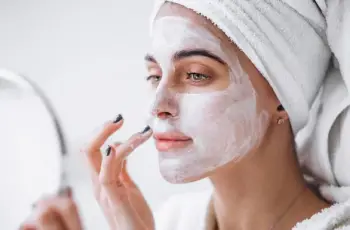
👁️ The Ultimate Guide to Eye Cream: How to Choose, Use & Love It
Eye creams are one of the most debated skincare products—some people swear by them, while others dismiss them as glorified moisturizers packed into tiny, expensive jars.
But the truth lies somewhere in between.
The skin around your eyes is delicate, about 40% thinner than the rest of your face, and it’s more vulnerable to signs of aging, fatigue, and environmental stressors like sun damage and pollution.
Because this area is constantly in motion—blinking, smiling, squinting—it wears down faster than other parts of your face, making a targeted product extremely beneficial.
When chosen wisely and used consistently, eye creams can help hydrate, firm, brighten, and protect your under-eye area, helping you look more refreshed and youthful.
In this guide, we’ll explore what eye creams actually do, who needs them, how to apply them correctly, which ingredients work best, and when to start using one in your skincare routine.
🧴 What Does Eye Cream Actually Do?
The eye area’s thinner skin loses moisture quickly, making it more susceptible to dryness, wrinkles, puffiness, and dark circles, especially as collagen levels naturally decline with age.
A well-formulated eye cream is designed to target these common concerns with concentrated ingredients that are gentle yet effective on the fragile under-eye area.
They deliver moisture to plump fine lines, support collagen production to firm skin, calm inflammation to reduce puffiness, and brighten pigmentation to fade dark circles.
While results won’t be instant, consistent use can help prevent premature aging and maintain smoother, brighter, and firmer under-eyes as you get older.
🌟 Key Eye Cream Benefits at a Glance:
Hydration: Prevents dryness and keeps the under-eye area soft and supple.
Wrinkle Reduction: Minimizes fine lines and crow’s feet through active ingredients like retinol and peptides.
De-Puffing: Calms inflammation and improves fluid drainage to reduce puffiness.
Brightening: Fades dark circles and evens tone using antioxidants and skin-repairing ingredients.
Firming: Enhances skin elasticity with peptides and collagen boosters to tighten sagging skin.
✨ Key Ingredients That Make Eye Creams Work
Not all eye creams are created equal, and the right one depends on your skin concerns—whether it’s puffiness, dark circles, wrinkles, or dryness.
Here are the most effective, dermatologist-approved ingredients you should look for in an eye cream, along with what they actually do:
💧 Hyaluronic Acid
This hydration powerhouse draws moisture into the skin, holding up to 1,000 times its weight in water, making the under-eye area appear plumper and less lined.
Perfect for dry, tired eyes that look dull or crepey due to moisture loss, it adds an immediate smoothing effect with long-term hydrating benefits.
🍊 Vitamin C
A brightening antioxidant that evens skin tone and fades pigmentation, Vitamin C also boosts collagen production and protects from free radical damage.
Ideal for dark circles caused by pigmentation and sun damage, especially when used in the morning for added protection.
🧬 Peptides
Peptides are small chains of amino acids that act as messengers, signaling the skin to repair itself and build more collagen and elastin.
They help tighten and firm the under-eye area over time, improving resilience and reducing the look of fine lines and sagging skin.
☕ Caffeine
Caffeine works by constricting blood vessels, which can reduce puffiness and dark discoloration caused by fluid retention or poor circulation.
It provides a quick fix for swollen, tired eyes and is best applied in the morning to refresh and awaken the under-eye area.
✨ Retinol
Retinol is a form of Vitamin A that accelerates cell turnover and collagen synthesis, making it a powerful anti-aging ingredient.
Because the eye area is sensitive, retinol should be used in small amounts in a gentle, eye-safe formula to avoid irritation.
🌿 Niacinamide (Vitamin B3)
A multitasking vitamin that brightens, soothes, strengthens the skin barrier, and improves elasticity without irritation.
Great for sensitive under-eyes with redness, uneven tone, or dark circles due to hyperpigmentation or inflammation.
🧼 How to Apply Eye Cream for Best Results
Technique matters when applying eye cream, since the area is thin and easily damaged by tugging, rubbing, or overuse.
Start by dispensing a pea-sized amount and use your ring finger—the weakest finger—to gently tap the product onto the skin.
Begin at the outer corner and pat inward along the orbital bone, avoiding the eyelid unless the product says it’s safe for lid application.
Avoid rubbing or smearing the cream, which can stretch the skin and accelerate wrinkles over time.
Less is more—too much product can clog pores or migrate into the eye, causing irritation or puffiness.
🕒 When to Use Eye Cream—And Why Timing Matters
For best results, eye cream should be used twice a day: once in the morning and again at night before bed, but the formulation may vary.
☀️ In the Morning
Use lightweight, fast-absorbing formulas with caffeine, Vitamin C, and hyaluronic acid to brighten and depuff.
These are great for prepping the area for makeup, helping concealer apply smoothly and last longer without creasing.
🌙 At Night
Use richer, reparative creams containing retinol, peptides, or ceramides to support overnight regeneration.
Nighttime is when your skin repairs itself, making it the perfect time for more active ingredients to do their work.
⚠️ Special Note on Retinol Eye Creams
Retinol can be very effective, but it may cause irritation when used too frequently or at high strengths.
Start slowly—2 to 3 times a week—and always patch test before applying to your entire eye area.
Pair with a hydrating eye cream or barrier-repair serum to reduce the risk of dryness, flaking, or sensitivity.
💤 Beyond Cream: Healthy Habits for Brighter Eyes
An eye cream alone won’t fix every concern—you also need supportive lifestyle habits to maintain results and protect this sensitive skin.
🌙 Get Enough Sleep
Aim for 7 to 9 hours per night so your skin has time to regenerate, repair damaged cells, and restore hydration levels.
🧊 Sleep Smarter
Sleep on your back with your head elevated to minimize fluid retention, which causes morning puffiness and under-eye bags.
☀️ Use Sunscreen Daily
Sun exposure breaks down collagen and accelerates wrinkles, so apply SPF around your eyes or choose an eye cream with built-in broad-spectrum sun protection.
💧 Drink Plenty of Water
Hydration keeps your skin cells plump and reduces the appearance of fine lines, dullness, and puffiness.
🥗 Eat Skin-Healthy Foods
Antioxidant-rich foods like berries, leafy greens, and fatty fish support skin health from within, while excess salt and sugar can worsen puffiness and dark circles.
💡 Common Eye Cream FAQs
Q: When should I start using eye cream?
Most dermatologists recommend starting around age 25, when collagen begins to decrease, and early signs of aging may start to appear.
Q: Is it absolutely necessary to use an eye cream?
If you have no major concerns and your facial moisturizer works well under the eyes, you might not need a separate product—but targeted formulas offer real benefits.
Q: Can I use eye cream on my eyelids?
Only if the label says it’s safe for eyelid use—most formulas are not tested or approved for use that close to the eye.
Q: What’s the difference between eye cream and eye balm?
Eye creams tend to be lightweight and quickly absorbed, while balms are thicker and more nourishing, ideal for dry or mature skin types.
Eye Cream Do’s and Don’ts
✔️ DO:
Apply gently using the ring finger
Use morning and night for best results
Pair with sunscreen daily
Store Vitamin C and retinol products in a cool, dark place
Be consistent—results can take 4 to 6 weeks
❌ DON’T:
Rub or tug the eye area
Use too much product at once
Apply expired or improperly stored creams
Expect instant results—eye creams are a long-term investment
Neglect healthy habits like sleep, hydration, and nutrition
✨ Is Eye Cream Really Worth It?
If you choose the right formula for your skin’s unique needs and use it consistently, yes—eye cream is absolutely worth the investment.
While it won’t perform miracles overnight, a well-formulated product can hydrate, smooth, brighten, and protect this delicate area with time.
Think of it as part of your larger skin wellness plan—a small step with big payoff when paired with a balanced lifestyle and proper self-care.
💬 What Should You Read Next?
Curious about how to build a complete anti-aging skincare routine?
Want help choosing between serums and creams for different concerns?
Let us know in the comments or check out our guide to treating under-eye wrinkles and puffiness naturally and effectively.
Skincare doesn’t have to be overwhelming—just consistent, thoughtful, and tailored to your unique skin needs.
Your eyes deserve a little love—they’re the first place others look and the first to show how you feel.


